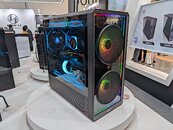
LIAN LI Launches Vector V100 Entry-Level Gaming Case
LIAN LI Industrial Co. Ltd., a leading manufacturer of chassis and PC accessories, announces the Vector V100, a sleek mid-tower chassis designed for builders seeking elegance and performance. Featuring pillarless front and side tempered glass panels, the Vector V100 showcases internal components with uninterrupted clarity. Its slanted front PSU shroud conceals a display platform, perfect for personalizing builds with collectibles. With support for back-connect ATX and microATX motherboards, robust cooling options—including up to a 360 mm radiator and 9 x 120 mm fans—and compatibility for large 415 mm GPUs, the Vector V100 is engineered for both style and capability. The case includes a GB-001 GPU anti-sag bracket and is available in black and white, with options for a barebone configuration or four pre-installed 120 mm ARGB/PWM fans.
Sleek Design with Showcase Potential
The Vector V100 is designed with modern aesthetics in mind, featuring pillarless tempered glass panels at the front and side that create a clean, unobstructed view of the internal components. Adding to its distinct style, the slanted front PSU shroud introduces a concealed display platform, perfect for showcasing collectibles or unique hardware. Complementing its modern look, the Vector V100 also includes a diffused addressable 26-LED strip along the PSU shroud, providing vibrant and customizable lighting, compatible with all motherboard software, that accentuates the build's aesthetics.
Sleek Design with Showcase Potential
The Vector V100 is designed with modern aesthetics in mind, featuring pillarless tempered glass panels at the front and side that create a clean, unobstructed view of the internal components. Adding to its distinct style, the slanted front PSU shroud introduces a concealed display platform, perfect for showcasing collectibles or unique hardware. Complementing its modern look, the Vector V100 also includes a diffused addressable 26-LED strip along the PSU shroud, providing vibrant and customizable lighting, compatible with all motherboard software, that accentuates the build's aesthetics.















































































